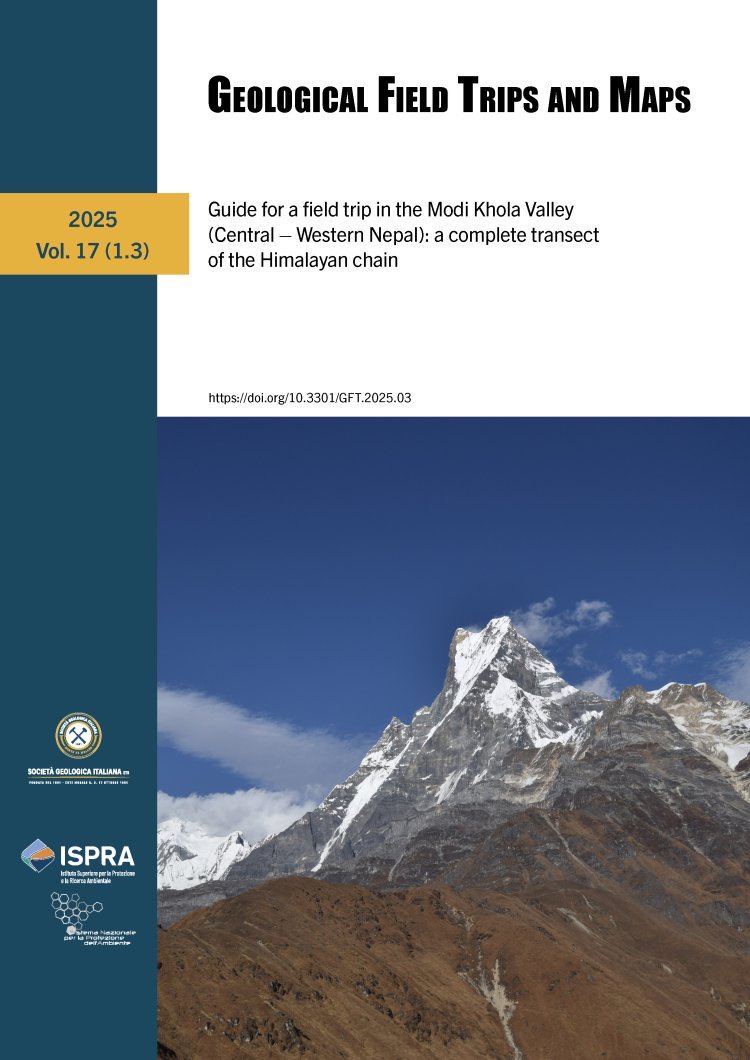
Volume 17 (1.3)/2025
Guide for a field trip in the Modi Khola Valley (Central – Western Nepal): a complete transect of the Himalayan chain
DOI: https://doi.org/10.3301/GFT.2025.03 - Pages: 1-28
Giorgia Carano1
1Politecnico di Torino, Department of Environment, Land and Infrastructure Engineering (DIATI), Corso Duca degli Abruzzi 24, 10129 Turin, Italy.
Corresponding author e-mail address: giorgia.carano@polito.it
Corresponding author e-mail address: giorgia.carano@polito.it
Abstract
The Modi Khola valley in the Annapurna Region in central-western Nepal offers a unique opportunity to study the complete tectonic and metamorphic history of the area, thanks to the exceptional continuity and exposure of the outcrops and the excellent orientation with respect to the chain. The valley exposes an about 20 km transect of rocks belonging to the three main tectono-metamorphic units of the Himalayan chain. From the lower to the upper structural level it is possible to recognise: the medium-low grade metamorphic rocks of the Lesser Himalayan Sequence (LHS), the medium-high-grade metamorphic rocks of the Greater Himalayan Sequence (GHS), and the weakly or non-metamorphic rocks of the Tethyan Himalayan
Sequence (THS). The main foliation in the three metamorphic units has a NW-SE trend and is generally dipping 40-45° towards N-NE.
The metamorphic core of the chain, the GHS, is separated from the THS by the South Tibetan Detachment System (STDS; that in the area is named Mardi-Himal Detachment) with normal kinematics and from the LHS by the Main Central Thrust Zone (MCTZ) with reverse kinematics. In the Modi Khola area other intra-GHS discontinuities are present. From top to bottom: the Modi Khola Shear Zone (MKSZ), the Sinuwa Thrust (ST), the Bhanuwa Fault (BT).
The field trip itinerary covers 13 stops along the Modi Khola valley, providing insights into the tectonic and metamorphic evolution of the units. The excursion requires a medium-easy trek with a total altitude difference of 2630 m, spanning from Birethanti village (1500 m a.s.l.) to the Annapurna Base Camp (ABC; 4130 m a.s.l.).
It is recommended to program at least 5 days to complete the itinerary. The guide emphasises regional and local discontinuities, highlighting the importance of structural and microstructural analysis due to the complexity of the area and the limited evidence of deformation in the lithologies at outcrop-scale.
Overall, the Modi Khola valley is a remarkable place where the geological setting and the tectonic and metamorphic evolution of the Himalayan region can be investigated. This field guide provides valuable insights for both researchers and geology enthusiasts interested in understanding the complex geological evolution of central-western Nepal and to better appreciate the history of the highest mountain belt in the world.
Keywords
